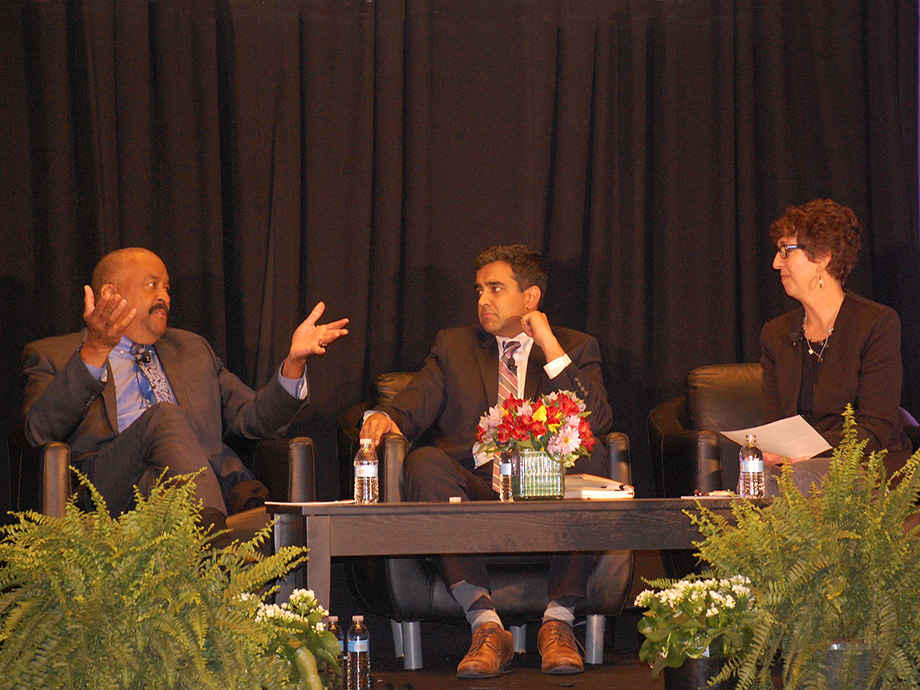National Health Policy Conference
Keynote Spotlights Community Work on Social Determinants
February 09, 2018, 11:40 am Michael Laff — Robert Ross, M.D., learned early in his career that many patients require medical care not because of illness or poor habits, but because they live in an unhealthy environment.

Ross, president and CEO of the California Endowment, an organization that works on issues related to access to care and social determinants of health, began to get active in community health initiatives when, as a pediatrician in Camden, N.J., he saw the crack cocaine epidemic begin to spread in the late 1980s.
"It was a rude introduction to the social determinants of health," he said. "A patient's ZIP code is a greater determinant for health outcomes than one's genetic code."
Ross discussed the endowment's strategies for addressing such factors through its Building Healthy Communities project in a keynote presentation at the National Health Policy Conference hosted by Academy Health Feb. 5-6.
He said too many patients are treated repeatedly for ailments that are unrelated to behavior, which indicates the need for a more aggressive community approach to public health.
Story Highlights
"After you've taken a roach out of a child's ear several times you might get desensitized," Ross said. "But then you ask yourself, 'Why am I taking a roach out of a child's ear in this country?'"
Now in its eighth year, Building Healthy Communities targets health inequities in 14 California communities, primarily low-income regions with high concentrations of ethnic minorities, such as South Los Angeles, East Oakland, Richmond, and City Heights in San Diego.
When the initiative began, organization staff sought to tackle basic health outcomes for each community, such as childhood obesity and teen violence. But when the goals were presented to community activists, the plan received a cold reception.
"They told us, 'We're not broken places that need to be fixed so you can make yourselves look good,'" Ross explained. "What the community taught us is that they are an asset. We decided not to frame our goals negatively. Our goals are positive."
Rather than highlight negative health indicators, Ross said the endowment shifted to empowerment slogans such as "Health happens in schools," "Health for all" and "Schools not prisons," and reframed its efforts.
The initiative now helps bring more locally grown fruits and vegetables into school meals and supports no-cost transportation for youth to access jobs and education in an area with low vehicle ownership rates. It started a land-use planning project in the Boyle Heights section of Los Angeles where the cemetery was the only safe place to walk.
"You have to broaden your definition of health," Ross said. "Then it's a question of how many initiatives can you fund? When you marry the science and evidence-based principles of medicine with the voice of the community, that's both the smart and right thing to do."
When the endowment asked community activists in Fresno what issue was most important, local residents pressed for changes to the school district's "zero tolerance" discipline policy, which was resulting in disproportionate suspensions of black and Latino students for classroom disruptions. Suspensions were contributing to a rise in students entering the criminal justice system at a young age.
"The worst thing you can do to a student when they act up is to suspend them," Ross said. "There's a reason why they are acting up."
Now the endowment is attempting to persuade public officials about the need to transfer funds from the criminal justice system to public health and prevention programs, an admittedly difficult political undertaking. But Ross said that any public health initiative aimed at inequities must address social justice and racial discrimination.
Ross cited successful examples such as work by the California Endowment that led to youth development meetings between the Salinas police chief and former gang members, and a ballot measure that helped free up criminal justice funds for prevention work by reducing penalties for some crimes.
For family physicians who want to measure and respond to the impact of social determinants on their patients' health, the AAFP recently launched an initial screening toolkit as part of The EveryONE Project. The toolkit contains questions that help physicians identify patient needs that might present barriers to better health.
Related AAFP News Coverage
EveryONE Project Unveils Social Determinants of Health Tools
(1/9/2018)